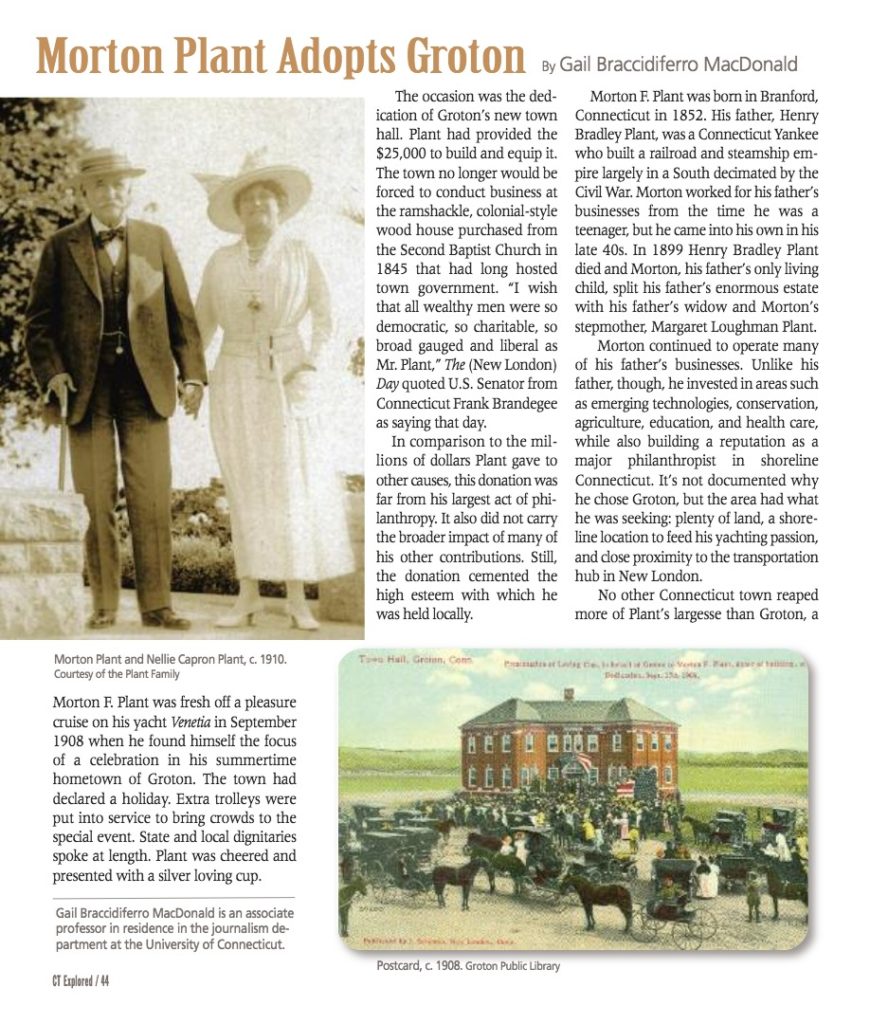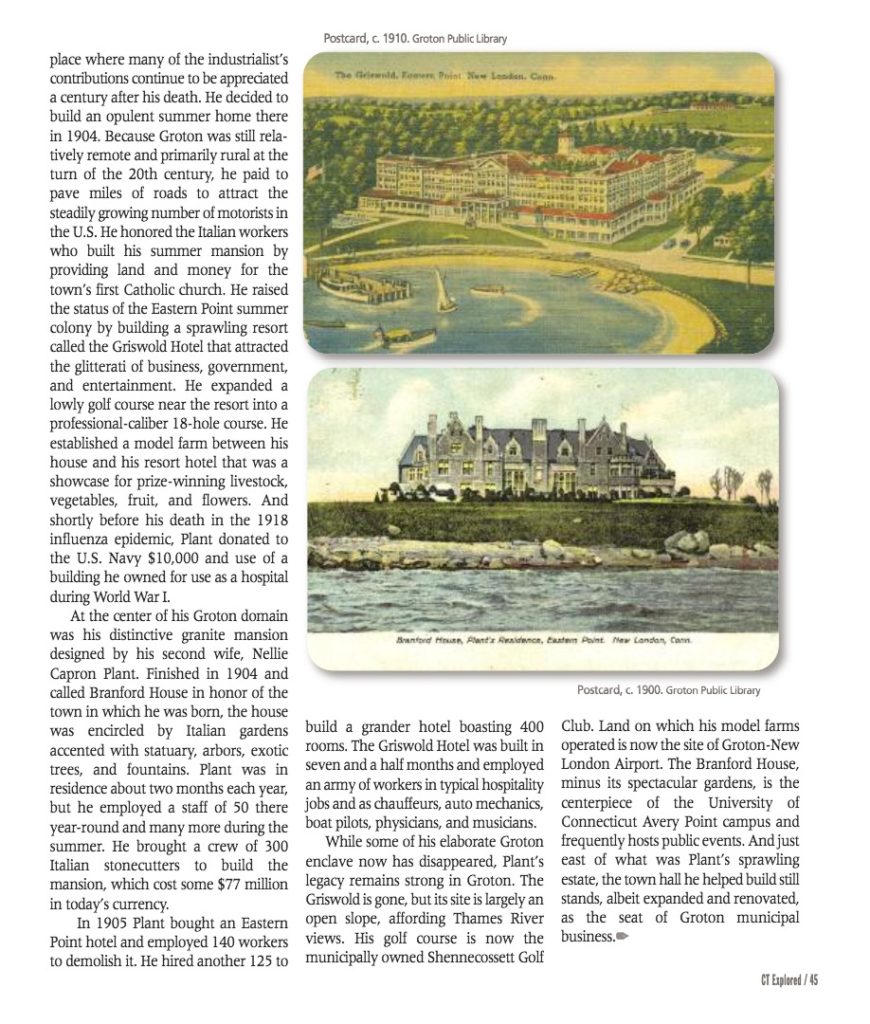 By Gail Braccidiferro MacDonald
By Gail Braccidiferro MacDonald
(c) Connecticut Explored Inc. Spring 2019
Subscribe/Buy the Issue!
Morton F. Plant was fresh off a pleasure cruise on his yacht in September 1908 when he found himself the focus of a celebration in his summertime hometown of Groton. The town had declared a holiday. Extra trolleys were put into service to bring crowds to the special event. State and local dignitaries spoke at length. Plant was cheered and presented with a silver loving cup.
The occasion was the dedication of Groton’s new town hall. Plant had provided the $25,000 to build and equip it. The town no longer would be forced to conduct business at the ramshackle, colonial-style wood house purchased from the Second Baptist Church in 1845 that had long hosted town government. “I wish that all wealthy men were so democratic, so charitable, so broad gauged and liberal as Mr. Plant,” The (New London) Day quoted U.S. Senator from Connecticut Frank Brandegee as saying that day.
In comparison to the millions of dollars Plant gave to other causes, this donation was far from his largest act of philanthropy. It also did not carry the broader impact of many of his other contributions. Still, the donation cemented the high esteem with which he was held locally.
Morton F. Plant was born in Branford, Connecticut in 1852. His father, Henry Bradley Plant, was a Connecticut Yankee who built a railroad and steamship empire largely in a South decimated by the Civil War. Morton worked for his father’s businesses from the time he was a teenager, but he came into his own in his late 40s. In 1899 Henry Bradley Plant died and Morton, his father’s only living child, split his father’s enormous estate with his father’s widow and Morton’s stepmother, Margaret Loughman Plant.
Morton continued to operate many of his father’s businesses. Unlike his father, though, he invested in areas such as emerging technologies, conservation, agriculture, education, and health care, while also building a reputation as a major philanthropist in shoreline Connecticut. It’s not documented why he chose Groton, but the area had what he was seeking: plenty of land, a shoreline location to feed his yachting passion, and close proximity to the transportation hub in New London.
 No other Connecticut town reaped more of Plant’s largesse than Groton, a place where many of the industrialist’s contributions continueto be appreciateda century after his death. He decided to build an opulent summer home there in 1904. Because Groton was still relatively remote and primarily rural at the turn of the 20th century, he paid to pave miles of roads to attract the steadily growing number of motorists in the U.S. He honored the Italian workers who built his summer mansion by providing land and money for the town’s first Catholic church. He raised the status of the Eastern Point summer colony by building a sprawling resort called the Griswold Hotel that attracted the glitterati of business, government, and entertainment. He expanded a lowly golf course near the resort into a professional-caliber 18-hole course. He established a model farm between his house and his resort hotel that was a showcase for prize-winning livestock, vegetables, fruit, and flowers. And shortly before his death in the 1918 influenza epidemic, Plant donated to the U.S. Navy $10,000 and use of a building he owned for a hospital during World War I.
No other Connecticut town reaped more of Plant’s largesse than Groton, a place where many of the industrialist’s contributions continueto be appreciateda century after his death. He decided to build an opulent summer home there in 1904. Because Groton was still relatively remote and primarily rural at the turn of the 20th century, he paid to pave miles of roads to attract the steadily growing number of motorists in the U.S. He honored the Italian workers who built his summer mansion by providing land and money for the town’s first Catholic church. He raised the status of the Eastern Point summer colony by building a sprawling resort called the Griswold Hotel that attracted the glitterati of business, government, and entertainment. He expanded a lowly golf course near the resort into a professional-caliber 18-hole course. He established a model farm between his house and his resort hotel that was a showcase for prize-winning livestock, vegetables, fruit, and flowers. And shortly before his death in the 1918 influenza epidemic, Plant donated to the U.S. Navy $10,000 and use of a building he owned for a hospital during World War I.
At the center of his Groton domain was his distinctive granite mansion designed by his second wife, Nellie Capron Plant. Finished in 1904 and called Branford House in honor of the town in which he was born, the house was encircled by Italian gardens accented with statuary, arbors, exotic trees, and fountains. Plant was in residence about two months each year, but he employed a staff of 50 there year-round and many more during the summer. He brought a crew of 300 Italian stonecutters to build the mansion, which cost some $77 million in today’s currency.
 In 1905 Plant bought an Eastern Point hotel and employed 140 workers to demolish it. He hired another 125 to build a grander hotel boasting 400 rooms. The Griswold Hotel was built in seven and a half months and employed an army of workers in typical hospitality jobs and as chauffeurs, auto mechanics, boat pilots, physicians, and musicians.
In 1905 Plant bought an Eastern Point hotel and employed 140 workers to demolish it. He hired another 125 to build a grander hotel boasting 400 rooms. The Griswold Hotel was built in seven and a half months and employed an army of workers in typical hospitality jobs and as chauffeurs, auto mechanics, boat pilots, physicians, and musicians.
While some of his elaborate Groton enclave now has disappeared, Plant’s legacy remains strong in Groton. The Griswold is gone, but its site is largely an open slope, affording Thames River views. His golf course is now the municipally owned Shennecossett Golf Club. Land on which his model farms operated is now the site of Groton-New London Airport. The Branford House, minus its spectacular gardens, is the centerpiece of the University of Connecticut Avery Point campus and frequently hosts public events. And just east of what was Plant’s sprawling estate, the town hall he helped build still stands, albeit expanded and renovated, as the seat of Groton municipal business.
Gail Braccidiferro MacDonald is an associate professor in residence in the journalism department at the University of Connecticut.
